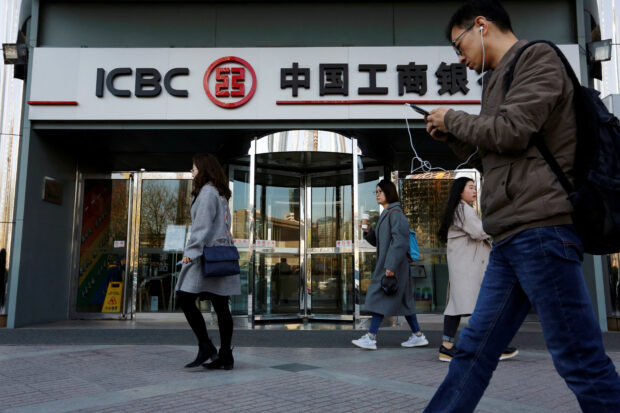
People walk past a branch of Industrial and Commercial Bank of China (ICBC) in Beijing, China. REUTERS/Florence Lo/File photo
BEIJING -A scramble by Chinese policymakers to tackle a debt crisis in the property sector and shore up the economy is set to deal a blow to the earnings prospects for big banks as they are pressed into the task of boosting credit demand.
China’s top five state-owned banks are expected to post a sharp decline in revenue and narrower net interest margins (NIM) as they turn in half-yearly results, with China Construction Bank kicking-off the reporting season on Wednesday.
The results will come against the backdrop of record-low credit growth in July, default risks at some housing developers and missed payments by a private wealth manager linked to shadow banking that has raised contagion risk to the broader economy.
The banks are also battling headwinds such as lower lending rates and pressure from the government to prop up the economy – which has been buffeted by weak demand both at home and abroad – as well as bad debt related to property developers and local government financing vehicles (LGFV).
“The biggest challenge for Chinese banks is navigating the increasingly low net interest margin as the credit demand remains subdued in the real economy,” said Gary Ng, senior economist at Natixis Corporate & Investment Banking.
“While there is support from greater exposure to government-related assets, it is more uncertain than ever on whether this can fully buffer the weak demand in households and corporates.”
China cut its one-year benchmark lending rate on Monday, which is set to further weigh on banks‘ NIM.
Chinese commercial banks‘ NIM shrank sharply to 1.74% last quarter from 1.91% at the end of 2022, official data showed.
The situation has worried authorities, with the central bank warning that banks needed to maintain a proper level of profit and NIM to ensure sustainability in supporting the real economy.
Downside risks
The half-yearly results of the top five banks and management commentary should help provide a glimpse into the near-term earnings outlook for the sector, as well as prospects for the world’s second-largest economy.
Industrial and Commercial Bank of China Ltd’s revenue is estimated to fall 8.7 percent year-on-year in the second quarter of this year, according to a median Refinitiv estimate.
Bank of Communications Co Ltd is estimated to report a 9.2- percent drop in revenue, while Agricultural Bank of China Ltd’s revenue is estimated to drop down 4.2 percent.
Shares of China’s biggest five banks have been sliding since early May amid concerns over the weakening economy.
In the near term, banks face downside risks including from their exposure to LGFV’s debt restructuring and developers’ default, analysts at JPMorgan said in a research report.
Debt-laden municipalities represent a major risk to China’s economy and financial stability, after years of over-investment in infrastructure and plummeting returns from land sales.
JPMorgan analysts estimate the government will take up the responsibility for about 10 percent of the debt facing interest payment problems, and then banks will roll over or restructure the remaining loans.
That would likely lead to a rise in credit cost of about 4 basis points and reduce NIM by about 6 basis points by 2025 for banks, they estimated.
In the property sector, banks will not just have to deal with defaults but also have to restructure loans, meaning less interest income in the coming years, said Christopher Beddor, deputy director of China research at Gavekal Dragonomics.
“The biggest challenge by far is net interest margins.”
“They could certainly do another deposit-rate cut, or even several. Still, there’s really no getting around the fact that banks will need to sacrifice profitability to support the economy this year,” Beddor added.

